Alex Bogusat and Rebecca Henricksen
Designed for Site #2 in Abu Dhabi, between Saadiyat Island and Yas Island.
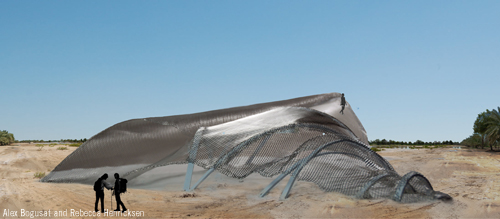
Design Submission for the 2010 Land Art Generator Initiative Design Competition
Artist’s descriptive text:
Concept and Energy
To us Site 3 represents a place of connections and relations to its surroundings, as it is enclosed by highways linking the airport, Masdar city, Abu Dhabi and the surrounding countryside. Our intention is to pay tribute to the link between the country’s regions: dessert, mountain and sea. We explored these regions, inspiring all aspects of our design, including its orientation, form and mosaic screen.
The artwork is in the form of a triangle, with each branch reaching out towards a different aspect of the Emirate connection to life. One branch rests on the ground and forms upward into a sand-dune like organic shape. The North-West branch begins below the surface of the earth where it will collect rainwater and form a reflection pond. This arm curls up in a wave-form (representing the sea) and unites with the dune branch to form a mountainous look-out view point, accessible to visitors by a path along the edge. From this vantage point, (11m high), visitors will be able to see the three connecting regions of the country, as well as have a 360’ view of the Masdar City sky-line.
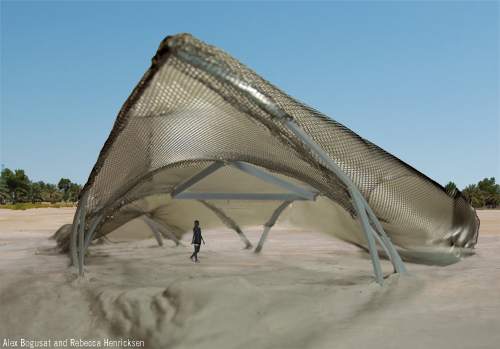
The sand-dune and mountainous elements of the artwork will be covered with energy photovoltaic cells (0.25m x 0.25m) that are allowed to blow fluidly in the wind, creating reflection patterns that mimic the sand dunes, and allowing the PV cells to capture the sun at many different angles on a continuous basis. The wind will allow for the PV cell shadows to dance and shift onto the ground below.
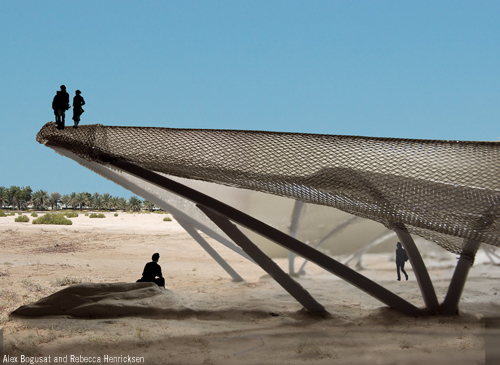
Environmental Impact Assessment
Basic mitigation strategy of our design initiative involves adhering to the principles laid out in the design brief, where our land art generator installation will be able to produce enough power to help alleviate the dependence of Abu Dhabi on fossil fuel generated power sources. The idea is to take the first step in alleviating population dependency on the burning of fossil fuels and in turn suggest alternative methods of sustainable energy production readily available to all. We want to address the issues of climate change and global warming and present this information in an understandable and educational way to site visitors everyday.
Our site strategy begins with the physical placement of our art installation. We wanted to adhere to a small footprint, and keep as much of the site untouched as possible. The artwork is placed in the South-West corner of the site in order to reduce its environmental impact, while creating a visible point of interest from the highway. The height is kept at a reasonable proportion in order to be visible to passing motorists both through and over the thin tree layer, yet it maintains its human scale as visitors are able to climb, touch, and feel before getting a great view of the nearby Masdar City skyline.
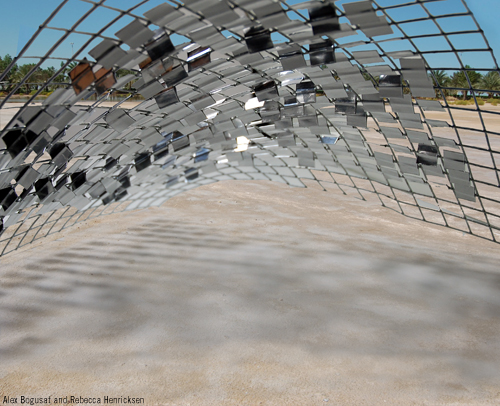
Solar Energy will be collected and stored underground where it will be linked to the energy grid of Masdar City. We are aware that there are production costs associated with the production of Photo-Voltaic Panels, including the high energy costs associated with silica production; however further consideration indicates that the benefits of the solar panel system will far outweigh the costs over little time. With the United Arab Emirates containing vast amounts of sand, this resource is considered a renewable commodity.
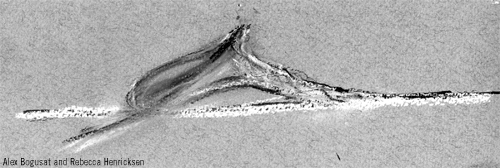
Structure
The Land Art Sculpture will be supported with arched steel columns approximately 0.5m wide. Steel is needed in order to support the organic shape of the form, and to enable the artwork to both connect with the land, and soar to heights of approximately 11m.
Related Posts
1 Comment
Add comment Cancel reply
This site uses Akismet to reduce spam. Learn how your comment data is processed.

[…] enable the artwork to both connect with the land, and soar to heights of approximately 11m. Source: Land Art Generator Initiative Reageer […]